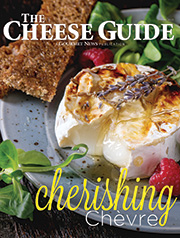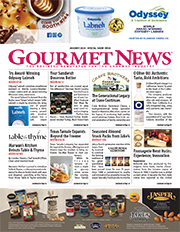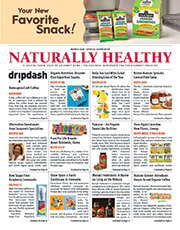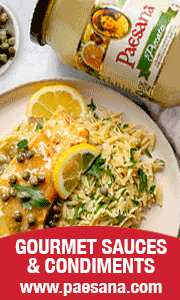Dr. Praeger’s Introduces Mexican-Style Street Corn Cheesy Bites
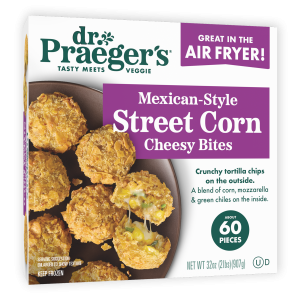 Dr. Praeger’s, a trusted name in better-for-you frozen foods, is building on the success of its category-leading snack offerings with the debut of Mexican-Style Street Corn Cheesy Bites. This latest innovation reflects the brand’s commitment to providing delicious, veggie-forward options that align with evolving consumer preferences for bold flavors and convenience.
Dr. Praeger’s, a trusted name in better-for-you frozen foods, is building on the success of its category-leading snack offerings with the debut of Mexican-Style Street Corn Cheesy Bites. This latest innovation reflects the brand’s commitment to providing delicious, veggie-forward options that align with evolving consumer preferences for bold flavors and convenience.
The bites are crafted with a crunchy corn tortilla chip coating and a creamy blend of corn, mozzarella, and green chilies, offering a savory and satisfying snacking experience. The bites are quick and versatile, ready to prepare straight from the freezer using an air fryer, stovetop, or oven.
Starting this month, the new bites will be available at more than 100 Costco locations across the Midwest, including states such as Illinois, Michigan and Wisconsin. Priced at $12.99 for a 60-count box, they deliver an enticing combination of quality, value, and convenience for families and snack enthusiasts.
“Snacking has become a cornerstone of how people eat, and we’re thrilled to expand our offerings with the launch of Mexican-Style Street Corn Cheesy Bites,” said Andy Reichgut, CEO of Dr. Praeger’s. “With the success of our Littles line, we’ve seen firsthand how much consumers love bold, veggie-forward snacks. These bites continue that, delivering craveable flavors and simple preparation while staying true to our mission of making veggies delicious and easy to eat.”
The launch underscores Dr. Praeger’s long standing dedication to developing plant-based, vegetable-driven foods that prioritize both flavor and nutrition. As the snack category continues to evolve, Mexican-Style Street Corn Cheesy Bites highlight the brand’s ability to innovate and meet the needs of modern consumers.
For more news of interest to the snacking industry, subscribe to Gourmet News.
Foodservice Trends Outlined at 2024 Summer Fancy Food Show
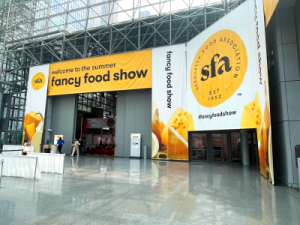 The first day of the 2024 Summer Fancy Food Show kicked off June 23 briskly. While the first day often doesn’t draw the crowds that pack the Javits Convention Center nearly as much as they do on the Monday following, many exhibitors and attendees expressed surprise at how the aisles filled up by midday.
The first day of the 2024 Summer Fancy Food Show kicked off June 23 briskly. While the first day often doesn’t draw the crowds that pack the Javits Convention Center nearly as much as they do on the Monday following, many exhibitors and attendees expressed surprise at how the aisles filled up by midday.
Nancy Kruse, founder of The Kruse Company, kicked off the show’s slate of talks Sunday with her presentation, “State of the Plate 2024: Outlook and Opportunity for Specialty Food” on the Main Stage. Kruse led the audience through the trends she identified as Comfort, Community, Curiosity, Proteins With Pedigrees, Vibrant Vegetables and Premium Finishes.
For comfort, one of the biggest trends is an American staple.
“It’s all about cheese,” Kruse said.
A prime example of this is the industry-shaking debut of Campbell’s Grilled Cheese & Tomato condensed soup, as well as the emergence of versions of the patty melt in restaurants.
Biscuits are on the uptick, she said, especially for the hot trend of daytime cafes that are open for breakfast, brunch and lunch.
Southern-style foods in general are on the rise, she said. Kruse also identified the trend of restaurants serving food on sheet pans, which she expects to expand to homes as well.
Americans are still consuming chicken at record levels, which Kruse expects to continue.
As an aside, Kruse said the use of lavender as an ingredient is something to keep an eye on because consumers are looking for soothing and relaxing flavors.
If there’s one thing that the industry needs to work on with comfort foods, she said, is texture.
Finding community is something that is primal for people, breaking bread together as well as sharing board games. This trend is all about countering the mad world of technology that we exist in.
“Food is analog, tactile and shareable.”
Charcuterie, chicken wings and fondue are three community trends that win for shareability that consumers crave, she said, adding that she hadn’t expected the fondue trend to resurface.
If you’ve paid attention to your friends and culture, you’ll know pickleball is more and more popular than ever, Kruse noted. Foodservice can capitalize on the trend by offering consumers pickle-themed menu items.
For the community trend, Kruse advised high concepts that are still familiar with consumers.
“The higher the technology, the higher the touch,” she said. “These foods are an offset to technology.”
Consumers’ curiosity about global tastes is thriving, Kruse said, including fusion foods.
“Fusion is alive and well,” she said, adding a cautionary note that earlier attempts at fusion led to “con-fusion,” mixing tastes that didn’t complement each other.
“Now it’s about compatible mixing,” she said, using Del Taco’s Shredded Beef Burria Ramen as an outstanding example – adding that burria in general is a hot trend. She also cited Velvet Taco’s WTF menu offerings – a revolving weekly offering of fusions such as the Pot sticker Taco.
The Latin pantry, such as First Watch’s Elote Mexican Street Taco Hashbrowns (noting the embedded definition of elote in the name as an example of appealing to Americans who may not be familiar or able to pronounce elote) the Italian pantry and Asian pantry as other global cuisines consumers are craving. In addition, she said that consumers are seeking global flavors at breakfast to start their days, too.
“Fusion is back,” she said, “although it never really went away. Mashups are huge.”
As far as proteins, Kruse said, Americans are bringing beef back into their diets, although they’re more selective about the beef they choose to eat. Restaurants are wise to exploit the brand and breed of the beef they offer to diners, as well as promoting premium cuts at popular prices.
Consumers also want to know how the cows were raised and sustainability efforts food manufacturers employ. Clean(er) food is important to consumers, she said, using McDonald’s surprising announcement to go from frozen meat to fresh without artificial ingredients in its menu items. Kruse also cited Chick-fil-A’s movement from offering NAE to NAIHM, which the industry took note of.
“The decision to go to NAE (no antibiotics ever) was monumental,” she said.
There was blowback from the industry (not in sales, she pointed out), so the company downgraded to no artificial ingredients important to human medicine.
Kruse advised the foodservice industry to keep an eye on regenerative agriculture, which consumers are watching, too.
“Promote the provenance,” she said, “and clean food claims.”
Mike Kurtz, the innovator of Mike’s Hot Honey who is credited with creating the hot honey craze, is focused on working with restaurants as well as CPGs to use Mike’s Hot Honey – as opposed to expanding the line, which remains as the original Mike’s Hot Honey and Extra Hot Honey.
“There’s so many places a brand can live,” he said.
From Utz potato chips to menus that feature his product, Kurtz said food manufacturers and restaurants are eager to feature Mike’s Hot Honey, letting consumers know the popular brand is included in ingredients.
From its creation as a pizza topper, shareability is in the DNA of Mike’s Hot Honey, he said, another example of how his brand fits with consumer and industry trends.
“It’s something people are moved to share,” Kurtz said. “Honey is, in itself, an ancient gift. It’s something that’s baked into the human existence.”
While vegan and vegetarian diets are more popular these days, they’re still a fraction of overall diets, Kruse said. Flexitarian is a segment that’s growing, she added, which foodservice should keep in mind.
Chick-fil-A’s thoughtful creation of its Cauliflower Sandwich, which takes into consideration flavor and texture, is a good example of a menu item appealing to vegan, vegetarian and flexitarian diners. Some restaurants are making more use of carrots – not just the carrot itself but the whole carrot with the greens – as well as collard greens.
“Try to think outside the crate,” she said.
Finally, she said, the trend toward using premium finishes on familiar foods is booming. French fry consumption is at a record high, she said. Foodservice is responded by topping them with such luxury touches as caviar, white truffles and Wagyu beef. Even Taco Bell has had limited time offers that have included truffles.
Americans are “loving lobster” and “craving caviar,” Kruse said. One Las Vegas restaurant has offered a gold-crusted burger, she said. Kruse stressed the importance of using food-grade gold to follow this trend, not anything from the local craft store.
Over at the Marky’s booth, one of the biggest U.S. purveyors of caviar and other luxe seafood offerings is seeing this resurgence of caviar on Americans’ plates. Once as common as ketchup, caviar moved into the luxury foods when someone realized the marketing value, eventually moving from an expensive food to exclusive due to the rising prices.
However, in recent years – thanks to the rising use of farm-raised sturgeon supplying the caviar – caviar’s popularity is rising. Consumers are more aware of the different kinds of caviar as well as the fact that sturgeon is the only source of caviar, with other fish eggs called roe.
In recent years, as another sign of how caviar is appealing to the masses, Marky’s installed a kiosk at New York City’s Grand Central Station, for commuters to grab a tin on their way to work or home.
Kruse said foodservice should serve its own “reality check” by not going too far into the luxurious touches. For instance, she cited TGI Friday’s steakhouse meatballs as a way of elevating a familiar menu item.
Americans emerging from the starkness of culinary offerings during the pandemic from FOMO (fear of missing out) to YOLO (you only live once), exercising what has been coined as “revenge spending.”
“While they eating out less often,” Kruse said, “they want their money’s worth.”
For more news of interest about the 2024 Summer Fancy Food Show, follow this blog or subscribe to Gourmet News.
Plant Based World Expo Engages Food Industry
 The third Plant Based World Expo North America returned to the Javits Center in New York on Sept. 8-9. Attendees at the 100 percent plant-based B2B industry event enjoyed innovative new plant-based products, speakers and networking opportunities. There were 3,722 attendees, up roughly 20 percent from 2021, and 232 exhibitors.
The third Plant Based World Expo North America returned to the Javits Center in New York on Sept. 8-9. Attendees at the 100 percent plant-based B2B industry event enjoyed innovative new plant-based products, speakers and networking opportunities. There were 3,722 attendees, up roughly 20 percent from 2021, and 232 exhibitors.
“The response to this year’s Plant Based World Expo has been tremendous,” said Chris Nemchek, general manager. “One of our goals this year was to improve the audience quality and increase the number of retail and foodservice buyers at the show, and we are thrilled to report that we increased the number of buyers by 20%.”
Trends on display included:
● Mushroom-based meats, snacks and jerky from Fable, Popadelics and Eat the Change.
● Plant-based meats and seafoods from companies such as Atlas Monroe, Hoya, Unlimeat, The Blue Butcher, Mind Blown Seafood and Finless Foods.
● Functional foods and beverages from Broma, True North, Remedy and Purposefuel.
● Snacks galore from Rule Breaker Snacks, Lupii, Mozaics and Fat Badger.
● Global culinary creativity and chef-crafted products.
● Convenient and accessible frozen and prepared entrees from companies such as Strong Roots and Wicked Foods.
● Elevated plant-based cheeses from Good Plant Foods, Bedda Cheese, Selfish Cow Plant Based Cheese, Plant Perks, Nuts for Cheese, Wildbrine and Miyoko’s Creamery.
“The success of this year’s Plant Based World Expo demonstrates the continued excitement around the plant-based foods industry,” said Rachel Dreskin, CEO of PBFA and The Institute. “Thanks to the strength of our partnership with the PBW team, we were able to put on a fantastic show featuring impactful conference sessions and so many meaningful opportunities for our members to connect with industry leaders and buyers. We look forward to continued growth and the expansion of our joint mission to showcase the power of plant-based.”
The show’s exhibitors were enthusiastic about their experiences at the show, citing great connections and the chance to showcase their products to a highly qualified audience as reasons why they plan to return next year.
“This was Mind Blown’s first year exhibiting at the show and it was incredible start to finish,” said Monica Talbert, co-founder of Mind Blown Plant Based Seafood Company. “The energy and excitement from attendees and other exhibitors was truly electric and so many quality connections really makes PBW a show not to miss!”
Whether they were sampling delicious plant-based frozen desserts and mouth-watering plant-based entrees or learning from expert speakers, celebrity chefs, and industry leaders, attendees agreed that this was the best PBW yet.
“The show has been incredible. We’ve made a lot of good contacts with all the right people to get our product into the right places. We’re looking forward to next year,” said Marc Elkman, co-founder, Mighty Yum.
“This was our first time coming to the show and we have made many amazing connections here–it gives me goosebumps–and we’re excited about following up and our future,” said Camille Holder-Brown, co-founder, Kale Cafe.
Read more about plant-based food in the October issue of Gourmet News. Subscribe today so you don’t miss it!
